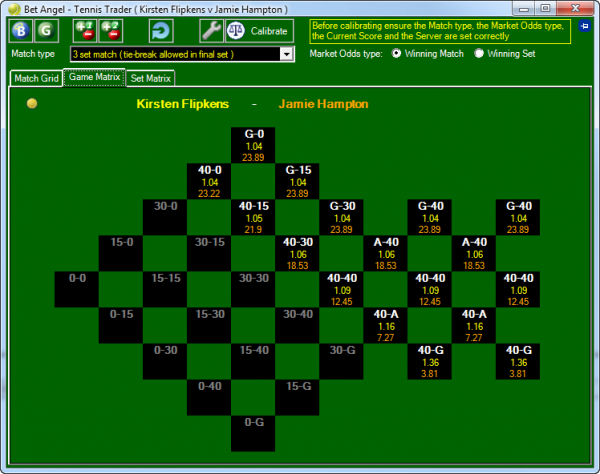In-game Tennis Trading
One of the beauties of Tennis trading is that there are many possible approaches which can all be successful, with some traders preferring to be exposed to risk, with others keener to take a more risk averse approach.
When laying a server, or the player a break up, we have previously discussed trading out if and when the break occurs. However for the purpose of this article, I want to look at taking money out during a service game.
To make matters slightly easier, I’ve grouped in-game scorelines into two brackets:-
- Small price movements: 1 Point Receiver Leads (no break point). This would be 0-15 and 15-30.
- Larger price movements: 2+ Point Receiver Leads, or 1 point break point leads. This would be 0-30, 0-40, 15-40, 30-40 or 40-A.
Typically, the price movement at 30-40 or 40-A will be bigger than at 0-15 or 15-30 due to the fact that it creates a break point opportunity for the receiver, whereas this is not the case at 0-15 or 15-30, which is why I have placed those scorelines in the second bracket.
I thought it would be pretty interesting to see how frequently these winning trade positions were hit during the average match (with no game selection) in various sets. However, before moving onto the actual stats, I will say that each set tends to have different dynamics.
My Game State spreadsheets illustrate this – for example, in the entire 2014 WTA season, the player a break down recovered the first break in the first set 52.8% of the time. However, in the second set, when a player was a set and break down, this deficit was recovered just 40.3% of the time. In the final set, this figure rose to the highest of all sets, 54.1%. It is not entirely surprising that the second set, from a set and break position, was the lowest percentage, as this position exhibits the most dominance from all three scenarios.
The following table shows the percentage small and larger price movements were achieved from a break down in the WTA, in January 2015:-
| WTA Jan 2015 | Player Break Down | Player Break Down | ||||||
| Got to only | Got to at least | |||||||
| 0-15/15-30 | 0-30/15-40/30-40/40-A | |||||||
| Total Situations | Situations | Yes | No | Yes | 2 Pts/BP % | 1 Point at least % | Difference | |
| Set 1 |
208 |
63 |
18 |
45 |
145 |
69.7 |
78.4 |
8.7 |
| Set 2 S&B |
150 |
62 |
23 |
39 |
88 |
58.7 |
74.0 |
15.3 |
| Set 3 |
74 |
26 |
8 |
18 |
48 |
64.9 |
75.7 |
10.8 |
| Overall |
432 |
151 |
49 |
102 |
281 |
65.0 |
76.4 |
11.3 |
The sample is quite revealing. A one point lead (smaller price movement) was achieved quite consistently throughout the sets, with set two, unsurprisingly, slightly lower than sets one or three.
Set one achieved the most success, with 78.4% of break leads going to at least 0-15 or 15-30. 69.7% achieved a bigger price movement, so only 8.7% of smaller price movements did not make it to the bigger price movement. This difference was almost doubled in set 2, from a set and break deficit, with a 15.3% difference between the smaller price movement percentage (74.0%) and the larger price movement percentage of 58.7%. How does this affect the way we trade?
We can use this information to help work out optimal exit points – for example, with the smallest difference between smaller and larger price movements in set one, we can look to hold on for larger price movements, knowing they are almost always achieved from a smaller price movement situation. Conversely, at a scoreline like 0-15 or 15-30 from a set and break deficit in set two, we may wish to clear a decent amount of liability, knowing that these scenarios develop to a larger price movement much less frequently.
This is a pretty decent example of what traders can achieve just throwing an hour or two at some research with trading applications – something I’d recommend all to do.
Many Thanks to Dan Weston who was the guest poster for this article, visit Dan’s excellent Tennis ratings site for lots of useful Tennis stats.
![]()
Category: Tennis, Trading strategies






